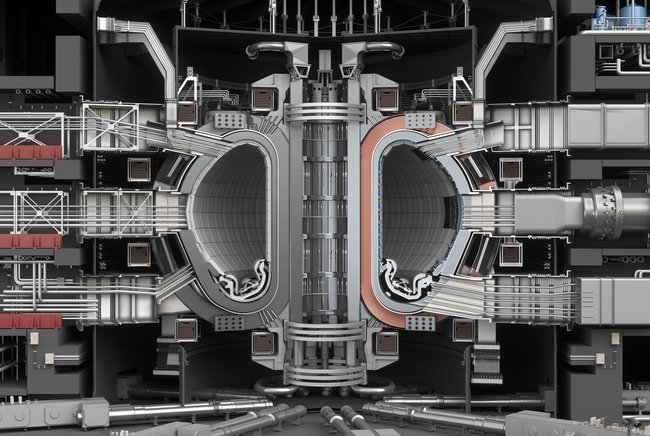Plasma-wall interaction processes in dense thermal plasmas
Jonathan van den Berg defended his thesis at the department of Applied Physics on July 8th.

In a world running into the limits of fossil fuel-driven growth, nuclear fusion energy would provide a sustainable power source with a small carbon footprint that can provide energy for the growing world population, while retaining the worlds ecosystems. In the world’s largest fusion device currently under construction, ITER, the plasma is confined in a magnetic field. Nevertheless , the exhaust of this plasma comes in contact with the wall, where damage can occur. One of the main questions for ITER is thus: will we be able to reach the conditions for fusion while protecting the wall from quick deterioration? For his PhD research, Jonathan van den Berg explored the processes that emerge in plasmas to protect the walls of ITER.
Nuclear fusion power can be realised by confining a deuterium-tritium plasma (.e. an ionised gas of ions and electrons, at a temperature of 150 million degrees. One fusion device that facilitate this is ITER, the world’s largest ever fusion device which is currently under construction. In ITER, unprecedented plasma conditions are expected, but the acceptable levels of wall erosion and heat loads are technically limited.
Plasma wall protection
And it’s this plasma-wall interaction processes that Jonathan van den Berg has studied as part of his PhD research in the group Science and Technology of Nuclear Fusion at TU/e. His research has shown that in the dense collisional plasma conditions expected in ITER, a process emerges that acts to protect the wall: the neutral-mediated plasma-wall interaction (n-PWI).
Van den Berg came across this process through a series of experiments in the linear plasma generator Magnum-PSI, under plasma conditions similar to those in ITER. A new diagnostic was introduced on the machine; namely coherent Thomson scattering (CTS). This diagnostic was used to measure the plasma flow velocity. Close to the surface, the velocity turned out to be much lower than expected for frictionless flow, especially in dense plasma conditions.
The source of the neutral interactions
This plasma flow on the wall exists as the surface is a plasma sink: once a charged ion and electron reach the wall, they recombine to form a neutral particle. These neutral particles can interact with the plasma to exchange momentum and energy. With increasing plasma density, this interaction gets more intense. The plasma power is then partially transmitted to the wall by many cold neutral particles, instead of few energetic ions: a neutral-mediated plasma-wall interaction.
Van den Berg’s results show that the wall material is expected to wear out less quickly. Moreover, the friction of the neutral cloud slows down the plasma. Therefore, at the technically limited maximum surface heat load, a higher plasma pressure is reached in the reactor. And the higher the plasma pressure, the higher the fusion power. The possible presence of near-surface plasma-neutral coupling in ITER improves the prospects of reaching the conditions required for a fusion power plant.
Van den Berg confirmed these results using a modelling study of the near-surface region in Magnum-PSI, using the B2.5-Eunomia plasma simulation code. A quantification of these effects in ITER requires further research. As the n-PWI occurs within only a few millimeters from the wall surface, the main model used for such simulation studies, SOLPS-ITER, does not yet consider the near-surface region in sufficient detail.
In future work, new simulations with this code could shed more light on the effects of n-PWI in ITER. As a result, the plasma-wall interaction processes in ITER and future devices can be further understood.
Title of PhD thesis: “Plasma-wall interaction processes in dense thermal plasmas”. Supervisors: Gerard van Rooij (TU/e), Niek Lopes Cardozo (TU/e), and Hennie van der Meiden (External).
Media contact
Latest news


